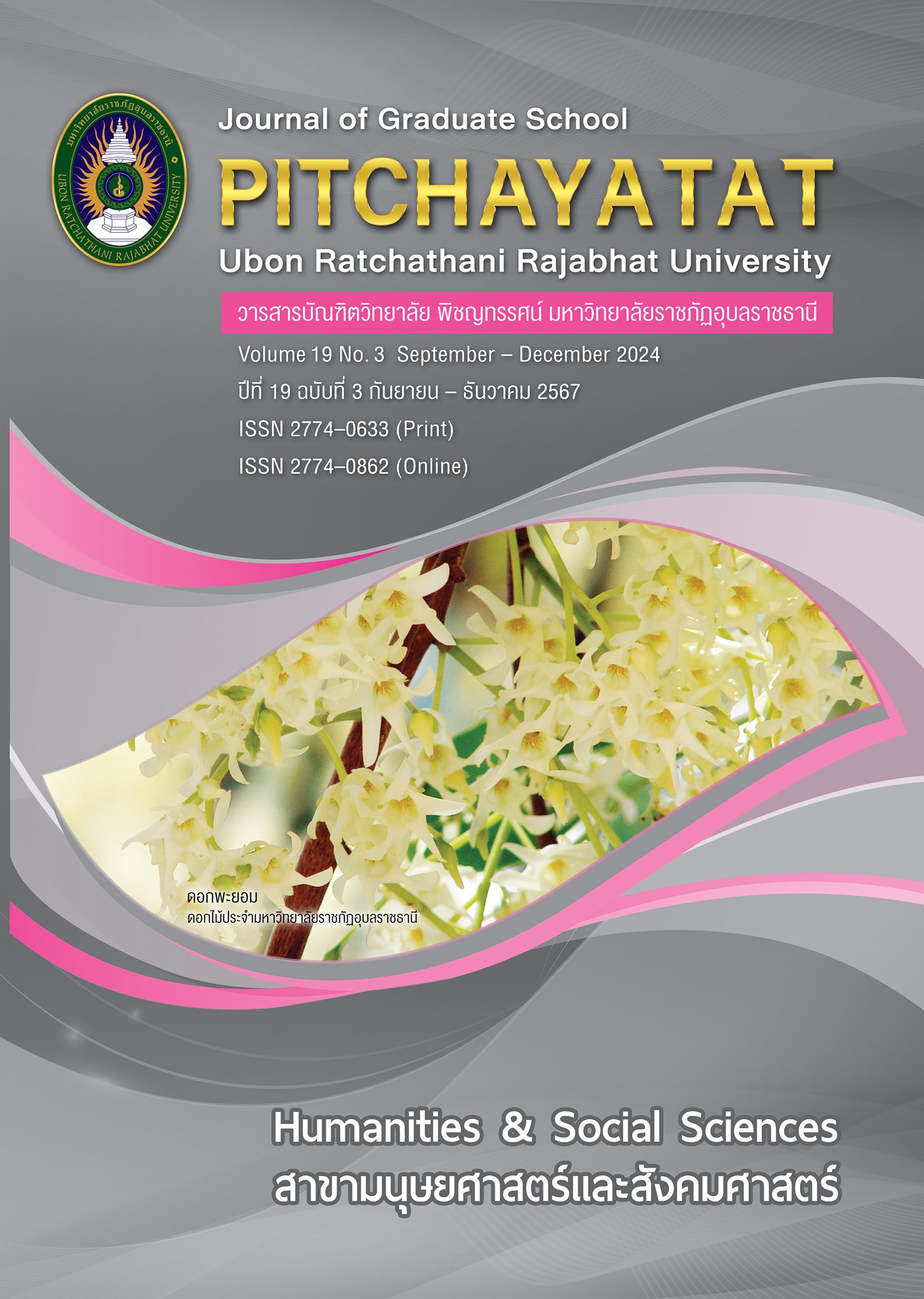Conditions, Needs, and Guidelines for Developing the Strategic Leadership in the 21st Century for the School Administrators under Sakon Nakhon Primary Educational Service Area Office 3
Keywords:
Strategic Leaderships in the 21st Century, Current and Desirable Situations, Need Assessment, Developmental Strategic Leaderships in the 21st CenturyAbstract
The objectives of this research were 1) to study the current and desirable conditions, 2) to evaluate the needs, and 3) to develop guidelines for developing the strategic leadership in the 21st century for the school administrators under Sakon Nakhon Primary Educational Service Area Office 3. The samples used in the research were 155 school administrators randomized by stratified sampling. The sample size was determined by using Krejcie and Morgan’s Table. The research instruments consisted of four forms: (1) a questionnaire asking for the current conditions of the strategic leadership in the 21st century of the school administrators with the index of the item discrimination between .75-.94 and the reliability of .99, (2) a questionnaire asking for the desirable conditions of the strategic leadership in the 21st century of the school administrators with index of the item discrimination between .83-.95 and the reliability of the whole questionnaire of .99, (3) a structured-interview form, and (4) an evaluation form used to evaluate the appropriateness and the possibility of the guidelines for developing the strategic leadership in the 21st century of thbe school administrators. All of the four forms of the research instruments had the Index of Item Objective Congruence: IOC of 1.00 in every item and form. The statistics used were mean, standard deviation, and Priority Needs Index Modified (PNIModified). The research findings were as follows. 1. The current conditions of the strategic leadership in the 21st century of the school administrators in the overall were at a high level. The desirable conditions of the strategic leadership in the 21st century of the school administrators in the overall were at the highest level. 2. The findings of the evaluation of the needs for developing the strategic leadership in the 21st century of the school administrators showed that the values of the aspects that were higher than the overall value and were organized from the highest to the lowest values were vision, ethics, and creativity. 3. The guidelines for developing the strategic leaderships in the 21st century of the school administrators were that in the vision, the school administrators should have the vision in administrating the schools, plan the operation to cover all activities, and bring the vision regulated to use in driving the operation to achieve the targets, in the ethics, the schools administrators should be honest and focus on the public benefits more than the personal benefits, perform with morality, and be good models for their staff, and in the creativity, the school administrators should have creative thinking to use in administrating education, accept the new ideas from people in the new generation, and bring the new ideas to use in the new administration related to the current situations. The findings of the evaluation showed that the development guidelines in the overall were appropriate at the highest level and possible at a high level.
References
กรรณิกา เรดมอนด์. ตัวบ่งชี้ทักษะภาวะผู้นำในศตวรรษที่ 21 สำหรับผู้บริหารสถานศึกษาขั้นพื้นฐาน.ดุษฎีนิพนธ์ศึกษาศาสตรดุษฎีบัณฑิต มหาวิทยาลัยมหามกุฎราชวิทยาลัย, 2559.
เขตพื้นที่การศึกษาประถมศึกษาสกลนคร เขต 3. สำนักงาน แผนการปฏิบัติงานประจำปี 2565. (ออนไลน์) 2565 (อ้างเมื่อ 30 กันยายน 2565). จาก https://sakonnakhon3.go.th/new/?p=14586#dearflip-df_15294/1/
จักรพันธุ์ จันทร์เจริญ. “ภาวะผู้นำเชิงกลยุทธ์ในศตวรรษที่ 21 ของผู้บริหารสถานศึกษาที่ส่งผลต่อแรงจูงใจในการปฏิบัติงานของครูโรงเรียนเอกชนสังกัดสำนักงานคณะกรรมการการศึกษาเอกชน (สช.) ในภาคตะวันออกเฉียงเหนือตอนกลาง,” วารสารวิชาการมหาวิทยาลัยนอร์ทกรุงเทพ. 10, 1 (กรกฎาคม–ธันวาคม 2564):1-16.
จันทร์วิมล วงศ์แดง. ภาวะผู้นำเชิงกลยุทธ์ของผู้บริหารสถานศึกษาในศตวรรษที่. วิทยานิพนธ์ครุศาสตรมหาบัณฑิต มหาวิทยาลัยราชภัฏสวนสุนันทา, 2564.
บุญชม ศรีสะอาด. การวิจัยเบื้องต้นฉบับปรับปรุง. พิมพ์ครั้งที่ 10. กรุงเทพฯ: สุวีริยาสาส์น, 2560.
ปรีดีนุกุล สมปรารถนา. คุณลักษณะของผู้นำเชิงกลยุทธ์ (Strategic Leadership). (ออนไลน์) 2565 (อ้างเมื่อ 12 ตุลาคม 2565). จากhttps://www.popticles.com/business/strategicleadership-characteristics/
วรวรรษ เทียมสุวรรณ และคณะ. “ภาวะผู้นำเชิงกลยุทธ์ในศตวรรษที่ 21.” วารสารวิชาการบัณฑิตวิทยาลัยสวนดุสิต. 15, 1 (พฤษภาคม–สิงหาคม 2562): 219–231.
วิรันทร์รัตน์ เสือจอย. ภาวะผู้นำเชิงกลยุทธ์ของผู้บริหารสถานศึกษาที่ส่งผลต่อคุณภาพผู้เรียนของโรงเรียน สังกัดสำนักงานเขตพื้นที่การศึกษามัธยมศึกษาสิงห์บุรี อ่างทอง. วิทยานิพนธ์ศึกษาศาสตร มหาบัณฑิต มหาวิทยาลัยศิลปากร. 2564.
สุรีรัตน์ โตเขียว. รูปแบบภาวะผู้นำของผู้บริหารสถานศึกษาขั้นพื้นฐานในศตวรรษที่ 21. วิทยานิพนธ์ศึกษาศาสตรดุษฎีบัณฑิต มหาวิทยาลัยราชภัฏนครสวรรค์, 2560.
สุวิมล ว่องวาณิช. การวิจัยประเมินความต้องการจำเป็น. พิมพ์ครั้งที่ 3. กรุงเทพฯ: คณะครุศาสตร์ จุฬาลงกรณ์มหาวิทยาลัย, 2558.
สายชล มัตถะปะโท. “ความต้องการจำเป็นในการพัฒนาคุณลักษณะของผู้บริหารสถานศึกษาในศตวรรษที่ 21 สังกัดสำนักงานเขตพื้นที่การศึกษาประถมศึกษาขอนแก่น เขต 5,” วารสาร มจร. อุบลปริทรรศน์. 6, 1 (พฤศจิกายน–ธันวาคม 2564): 55-68.
Krejcie, R. V. and D. W. Morgan. “Determining sample size for research activities,” Educational and psychological measurement, 30, 3 ( September 1970):607-610.
Downloads
Published
How to Cite
Issue
Section
License
Copyright (c) 2024 Journal of Graduate School, Pitchayatat, Ubon Ratchathani Rajabhat University

This work is licensed under a Creative Commons Attribution-NonCommercial-NoDerivatives 4.0 International License.
Every article is peer-reviewed for academic correctness by at least two external qualified experts. The opinions in the Journal of Graduate School, Pitchayatat, Ubon Ratchathani Rajabhat University (Humanities and Social Sciences) belong to the authors; not belong to the Publisher. Thus, Graduate School of Ubon Ratchathani Rajabhat University cannot to be held responsible for them. The articles in this journal are protected by the copyright of Thailand. No part of each issue may be reproduced for dissemination without written permission from the publisher.





